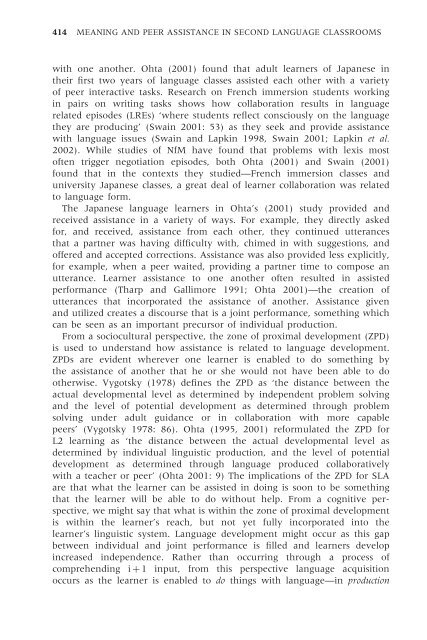Negotiation for Meaning and Peer Assistance in Second Language ...
Negotiation for Meaning and Peer Assistance in Second Language ...
Negotiation for Meaning and Peer Assistance in Second Language ...
You also want an ePaper? Increase the reach of your titles
YUMPU automatically turns print PDFs into web optimized ePapers that Google loves.
414 MEANING AND PEER ASSISTANCE IN SECOND LANGUAGE CLASSROOMS<br />
with one another. Ohta (2001) found that adult learners of Japanese <strong>in</strong><br />
their first two years of language classes assisted each other with a variety<br />
of peer <strong>in</strong>teractive tasks. Research on French immersion students work<strong>in</strong>g<br />
<strong>in</strong> pairs on writ<strong>in</strong>g tasks shows how collaboration results <strong>in</strong> language<br />
related episodes (LREs) ‘where students reflect consciously on the language<br />
they are produc<strong>in</strong>g’ (Swa<strong>in</strong> 2001: 53) as they seek <strong>and</strong> provide assistance<br />
with language issues (Swa<strong>in</strong> <strong>and</strong> Lapk<strong>in</strong> 1998, Swa<strong>in</strong> 2001; Lapk<strong>in</strong> et al.<br />
2002). While studies of NfM have found that problems with lexis most<br />
often trigger negotiation episodes, both Ohta (2001) <strong>and</strong> Swa<strong>in</strong> (2001)<br />
found that <strong>in</strong> the contexts they studied—French immersion classes <strong>and</strong><br />
university Japanese classes, a great deal of learner collaboration was related<br />
to language <strong>for</strong>m.<br />
The Japanese language learners <strong>in</strong> Ohta’s (2001) study provided <strong>and</strong><br />
received assistance <strong>in</strong> a variety of ways. For example, they directly asked<br />
<strong>for</strong>, <strong>and</strong> received, assistance from each other, they cont<strong>in</strong>ued utterances<br />
that a partner was hav<strong>in</strong>g difficulty with, chimed <strong>in</strong> with suggestions, <strong>and</strong><br />
offered <strong>and</strong> accepted corrections. <strong>Assistance</strong> was also provided less explicitly,<br />
<strong>for</strong> example, when a peer waited, provid<strong>in</strong>g a partner time to compose an<br />
utterance. Learner assistance to one another often resulted <strong>in</strong> assisted<br />
per<strong>for</strong>mance (Tharp <strong>and</strong> Gallimore 1991; Ohta 2001)—the creation of<br />
utterances that <strong>in</strong>corporated the assistance of another. <strong>Assistance</strong> given<br />
<strong>and</strong> utilized creates a discourse that is a jo<strong>in</strong>t per<strong>for</strong>mance, someth<strong>in</strong>g which<br />
can be seen as an important precursor of <strong>in</strong>dividual production.<br />
From a sociocultural perspective, the zone of proximal development (ZPD)<br />
is used to underst<strong>and</strong> how assistance is related to language development.<br />
ZPDs are evident wherever one learner is enabled to do someth<strong>in</strong>g by<br />
the assistance of another that he or she would not have been able to do<br />
otherwise. Vygotsky (1978) def<strong>in</strong>es the ZPD as ‘the distance between the<br />
actual developmental level as determ<strong>in</strong>ed by <strong>in</strong>dependent problem solv<strong>in</strong>g<br />
<strong>and</strong> the level of potential development as determ<strong>in</strong>ed through problem<br />
solv<strong>in</strong>g under adult guidance or <strong>in</strong> collaboration with more capable<br />
peers’ (Vygotsky 1978: 86). Ohta (1995, 2001) re<strong>for</strong>mulated the ZPD <strong>for</strong><br />
L2 learn<strong>in</strong>g as ‘the distance between the actual developmental level as<br />
determ<strong>in</strong>ed by <strong>in</strong>dividual l<strong>in</strong>guistic production, <strong>and</strong> the level of potential<br />
development as determ<strong>in</strong>ed through language produced collaboratively<br />
with a teacher or peer’ (Ohta 2001: 9) The implications of the ZPD <strong>for</strong> SLA<br />
are that what the learner can be assisted <strong>in</strong> do<strong>in</strong>g is soon to be someth<strong>in</strong>g<br />
that the learner will be able to do without help. From a cognitive perspective,<br />
we might say that what is with<strong>in</strong> the zone of proximal development<br />
is with<strong>in</strong> the learner’s reach, but not yet fully <strong>in</strong>corporated <strong>in</strong>to the<br />
learner’s l<strong>in</strong>guistic system. <strong>Language</strong> development might occur as this gap<br />
between <strong>in</strong>dividual <strong>and</strong> jo<strong>in</strong>t per<strong>for</strong>mance is filled <strong>and</strong> learners develop<br />
<strong>in</strong>creased <strong>in</strong>dependence. Rather than occurr<strong>in</strong>g through a process of<br />
comprehend<strong>in</strong>g i þ 1 <strong>in</strong>put, from this perspective language acquisition<br />
occurs as the learner is enabled to do th<strong>in</strong>gs with language—<strong>in</strong> production














